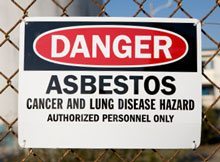Mesothelioma Report Shows All Types of Asbestos Can Be Lethal

A new report from researchers at Massachusetts General Hospital in Boston confirms what many scientists have long believed – that no type of asbestos is “safe” and that all can lead to malignant mesothelioma.
In a study of 62 malignant peritoneal mesothelioma patients published in the American Journal of Industrial Medicine, the researchers found that more than a quarter of the cases of diffuse peritoneal mesothelioma were linked to chrysotile asbestos alone.
The news appears to contradict the argument, made some some companies that mined or used asbestos, that chrysotile asbestos is less deadly than other varieties.
Asbestos Varieties and Mesothelioma
Asbestos mineral fibers come in several different varieties. The most common is the serpentine-shaped chrysotile or “white” asbestos found in roof tiles, ceilings, walls, and floors of many older homes and businesses.
There are also five amphibole varieties of asbestos including actinolite, amosite, anthophyllite, crocidolite, and tremolite. These fibers have a straight shape and were prized for their heat resistance.
Although some have tried to argue that chrysotile asbestos is less dangerous than amphibole, the US Department of Health and Human Services, the International Agency for Research on Cancer, and the EPA classify all types of asbestos as carcinogenic, capable of causing malignant mesothelioma.
Assessing the Causes of Mesothelioma
After analyzing the medical records and legal cases of 51 men and 11 women with diffuse peritoneal mesothelioma, the Massachusetts General researchers found that 26 percent of cases were caused by chrysotile asbestos exposure alone.
In fact, among the mesothelioma cases in people who did not directly work with asbestos (paraoccupational exposure), half of them were exposed only to chrysotile asbestos, suggesting that chrysotile, like other types of asbestos, can cause mesothelioma and other cancers.
Mesothelioma’s Long Latency
Previous studies have demonstrated that, the longer a person is exposed to asbestos, the higher the likelihood that they will eventually receive a mesothelioma diagnosis. Nevertheless, shorter exposure is not necessarily safer. Patients in the new study were exposed to asbestos for an average of 17.9 years, but the shortest asbestos exposure duration before a mesothelioma diagnosis was less than 8 years.
Like other forms of asbestos, chrysotile can take a long time to do its destructive work, which sometimes makes it difficult to trace the cause of a case of mesothelioma. In the new study, the average time from a patient’s first asbestos exposure to their mesothelioma diagnosis was more than 45 years with the longest being more than 57 years.
What is Diffuse Peritoneal Mesothelioma?
Diffuse peritoneal mesothelioma is a virulent cancer that affects the lining around the abdominal organs. The overwhelming majority of diffuse peritoneal mesothelioma cases can be directly linked to asbestos exposure, either in the workplace or in the environment. Many women are exposed when they handle the contaminated clothing of a loved one.
Once asbestos enters the body, either via the lungs or the digestive tract, it tends to stay there, triggering inflammation and irritation that can result in mesothelioma decades later.
Source:
Kradin, RL, et al, “Diffuse peritoneal mesothelioma: A case series of 62 patients including paraoccupational exposures to chrysotile asbestos”, September 22, 2017, American Journal of Industrial Medicine, Epub ahead of print





